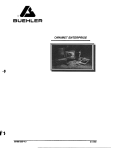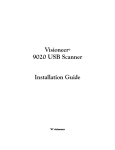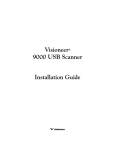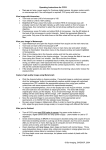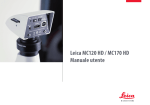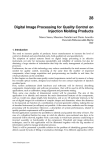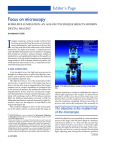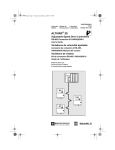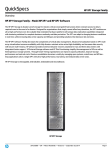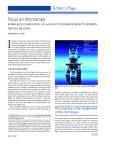Download DMC Ie Launch Brief
Transcript
Polaroid DMC Ie Digital Microscope Camera High-resolution images with speed and ease DMC Ie Digital Microscope Camera Table of contents Product Overview Polaroid DMC Ie Product Description . . . . . . . . . . . . . . . . . . . . . . . . . . . . . . . . . . . . . . . . . . . . . . . . . . . 1 Product and Accessories PIDs . . . . . . . . . . . . . . . . . . . . . . . . . . . . . . . . . . . . . . . . . . . . . . . . . . . . . . . . . . 2 Features and Benefits . . . . . . . . . . . . . . . . . . . . . . . . . . . . . . . . . . . . . . . . . . . . . . . . . . . . . . . . . . . . . . . . . 3 Technical Specifications . . . . . . . . . . . . . . . . . . . . . . . . . . . . . . . . . . . . . . . . . . . . . . . . . . . . . . . . . . . . . . . 4 System Requirements . . . . . . . . . . . . . . . . . . . . . . . . . . . . . . . . . . . . . . . . . . . . . . . . . . . . . . . . . . . . . . . . . 7 Question and Answer Guide . . . . . . . . . . . . . . . . . . . . . . . . . . . . . . . . . . . . . . . . . . . . . . . . . . . . . . . . . . . 8 Frequently Asked Technical Questions . . . . . . . . . . . . . . . . . . . . . . . . . . . . . . . . . . . . . . . . . . . . . . . . . . 9 Technical Background . . . . . . . . . . . . . . . . . . . . . . . . . . . . . . . . . . . . . . . . . . . . . . . . . . . . . . . . . . . . . . . 12 Markets and Applications Market Profile . . . . . . . . . . . . . . . . . . . . . . . . . . . . . . . . . . . . . . . . . . . . . . . . . . . . . . . . . . . . . . . . . . . . . . 15 Market Segment . . . . . . . . . . . . . . . . . . . . . . . . . . . . . . . . . . . . . . . . . . . . . . . . . . . . . . . . . . . . . . . . . . . . 15 Key Markets for Polaroid DMC Ie . . . . . . . . . . . . . . . . . . . . . . . . . . . . . . . . . . . . . . . . . . . . . . . . . . . . . 15 Competitive Analysis Positioning of the Polaroid DMC Ie . . . . . . . . . . . . . . . . . . . . . . . . . . . . . . . . . . . . . . . . . . . . . . . . . . . . 19 Bright Field Comparative Matrix . . . . . . . . . . . . . . . . . . . . . . . . . . . . . . . . . . . . . . . . . . . . . . . . . . . . . . 19 Competition-at-a-Glance . . . . . . . . . . . . . . . . . . . . . . . . . . . . . . . . . . . . . . . . . . . . . . . . . . . . . . . . . . . . . 20 Sales Support and Service Telephone Service . . . . . . . . . . . . . . . . . . . . . . . . . . . . . . . . . . . . . . . . . . . . . . . . . . . . . . . . . . . . . . . . . . . 23 Standard Warranty . . . . . . . . . . . . . . . . . . . . . . . . . . . . . . . . . . . . . . . . . . . . . . . . . . . . . . . . . . . . . . . . . . 23 Internet Service . . . . . . . . . . . . . . . . . . . . . . . . . . . . . . . . . . . . . . . . . . . . . . . . . . . . . . . . . . . . . . . . . . . . . 23 P O rod ve u rv ct ie w DMC Ie Digital Microscope Camera Polaroid Digital Microscope Camera DMC Ie Product Description The new Polaroid DMC Ie is an enhanced version of the Polaroid DMC digital microscope camera, adding greater value and extended capabilities. While many of the advanced features of the Polaroid DMC remain, they have been improved and reconfigured. With the Polaroid DMC Ie, you can get accurate color images with sharp edges and crisp shadow detail right on your computer screen. An improved preview mode in the Polaroid DMC Ie runs at a rate of up to 11 frames per second, allowing for easier framing and focusing of the sample before the final image is taken. In addition, the Polaroid DMC Ie captures detailed 12-bit linear RGB images, enabling you to make precise scientific measurements. Other notable improvements include a color focusing aid, automatic white balance and color correction. Polaroid’s commitment to advanced digital imaging technology has resulted in a digital microscope camera that creates an image with no practical difference in clarity or sharpness. The Polaroid DMC Ie gives heightened performance at an economical price. The Polaroid DMC Ie captures incredibly sharp images using a 12.15mm CCD, larger than a 2/3 inch* video format chip. Many other cameras use only a 1/2 inch or even 1/3 inch chip, which means you capture less of your image while, in most cases, you pay more! The Polaroid DMC Ie provides 1600x1200 pixel resolution, full-color images from any standard-size microscope at a price lower than many of those smaller-chip cameras. And the Polaroid DMC Ie makes 12-bit high-resolution scientific digital image capture easy for you. Installation couldn’t be simpler. All that is required is a standard, widely available “C-mount” adapter. Everything else you need to start capturing microscope images immediately is included: a 2-meter HD SCSI-2 cable, a 50-pin to 25-pin adapter, and a comprehensive online user manual. Compatible with both Windows and Macintosh formats, the Polaroid DMC Ie comes with imaging software that allows for instant operation with either system. Once you capture an image, the next step is up to you. The Polaroid DMC Ie software allows you to store files in the industry-standard TIFF format. Using the included Adobe Photoshop plug-in for Macintosh or TWAIN driver for Windows applications, you have the option of transferring files to your favorite image analysis, archiving and editing software, allowing for storage and manipulation in a variety of other file formats. Of course, in addition to the standard 1600x1200 pixel image, there are other output format options that allow for reduced file size and storage flexibility, including 800x600 and 400x300 in both color and black-and-white. A rapid camera-to-host data transfer speed, greater than 2 MB per second, eliminates the need for file compression, ensuring the fidelity of your images. And if you have more than one microscope, you can also have more than one Polaroid DMC Ie connected to a central computer. Each enhanced digital microscope camera comes with a dual SCSI connector, selectable SCSI ID and selectable active internal termination, all of which gives you the ability to connect all of your Polaroid DMC Ie cameras to one computer. * Please refer to page 9 for conversion of video format. 1 DMC Ie Digital Microscope Camera Polaroid DMC Ie Suggested List Price $5700 U.S. Dollars PID # U.S. PID# 100000 Japan PID# 100002 Asia-Pacific PID# 100006 Europe PID# 100010 Accessory PIDs 2 PID # Product 625504 Copy stand 625506 Repro lighting 625507 Close-up lens 629450 Advansys Abp-922 SCSI adapter 626688 Navitar 7000 lens 631159 Foot pedal 631158 Handheld remote cable release DMC Ie Digital Microscope Camera Features and Benefits Feature Benefit 12-Bit Linear RGB Excellent for use in analytic applications Color/Black & White Preview up to 11 Frames/Second Allows for easier framing and focusing before the image is captured Three Resolutions (1600x1200, 800x600, 400x300) Offers both high-resolution and storage flexibility Ability to “Daisy-chain” Multiple Cameras to Single Computer Increases productivity; reduces need for additional computer workstations C-mount Connection Easy to connect; no special adapters required 12.15mm Mega-pixel CCD Offers larger viewing area than any other camera on the market SCSI-2 Easy connection to any computer; fast information transfer TWAIN Drivers and Photoshop Plug-ins Compatibility with most imaging software Exposure Times from 20 msec. to 1 sec. Adapts to various lighting sources No Data Compression Maintains data integrity and image fidelity Included Camera Utility Software Allows for immediate operation 3 DMC Ie Digital Microscope Camera Technical Specifications CCD Grade Polaroid BIN 0 Total Point Defects < 176 No Cluster Defects No Column Defects CCD Format and Resolution 1656 x 620 pixels (1,026,720 pixels) 12 micron x 6 micron pixel size Active area 9.6 x 7.2 mm Image Acquisition Bit Depth 12-bit a/d conversion Digitization Pixel-by-pixel digitization in camera head Full Well Capacity 43,000 e (minimum) 70,000 e (typical) Total Amp Noise 21 e rms (typical) 30 e rms (maximum) Signal to Noise Ratio 66dB (typical) Binning Modes 2 x 3 (2 x n) IR Filter CM500N Pixel Readout Rate 5 MHz Exposure 20msec. - 1 sec. Lens Mount C-mount Fast Focus 11 subframes per second External Sync PC connector for external strobe Remote Mini phone 2.5mm trigger in universal Super High Resolution 1600 x 1200 File Size; • 8 bit = 1.92MB • 16 bit = 3.84MB • 24 bit = 5.76MB • 48 bit = 11.52MB 4 DMC Ie Digital Microscope Camera Technical Specifications (cont'd) High Resolution 800 x 600 File Size; • 8 bit = 0.48MB • 16 bit = 0.96MB • 24 bit = 1.44MB • 48 bit = 4.32MB Image Transfer Speed Greater than 2 MB/second SCSI data transfer Computer Interface SCSI-2 50-pin HD (2) Power Supply • IEC universal power adapter • Input: 100-250V, 0.38A, 50-60Hz (surge protected) • Output: +6.0 VDC, 3.0A • Class II, double insulated device • UL Approved, SA, CE, DVE Approved Software Manual Controls • External light source synchronization for copystand work • Film speed selection ISO 25, 50 or 100 • Color or Black-and-White • Brightness, contrast, sharpening and color controls • Shutter speed from 1/50 of a second up to 1 second • Black-and-White live preview at 7-11 frames per second Automatic Controls • Color correction • White balance Dimensions (h x l x w) 7.2 in. x 5.1 in. x 2.1 in. (18.3 cm x 13.0 cm x 5.3 cm) Weight 2.1 lbs. (963 g) 5 DMC Ie Digital Microscope Camera Standard Components Included in Base Configuration • Camera unit • 2-meter cable, 50 pin HD SCSI-2 connector • 50-pin to 25-pin adapter • IEC Universal power supply • Country version power cords • Online user manual • Quick start card Software Supplied • Camera utility software for Macintosh and Windows operating systems • TWAIN compliant driver for Windows • Photoshop plug-in for Macintosh Software Features • 16-bit or 8-bit capture • Fast, high resolution focus mode • Measurement Marker and Annotation Tool allow you to display a scale and add text to the image • Create measurement marker for each objective lens • Save your image capture settings • Automatic white balance and color correction • Preview zoom function • Thumbnail display • Color or black-and-white preview 6 DMC Ie Digital Microscope Camera IBM Recommended Operating Requirements • IBM PC or compatible with a Pentium processor • ASPI compliant SCSI adapter card • Windows 95, 98 or NT • 64 MB of available RAM • 10 MB of available hard disk space Macintosh Recommended Operating Requirements • Apple Macintosh or Powerbook computer with a Power PC or later processor • Macintosh operating system of 7.5 or later • 64 MB of available RAM • 10 MB of available hard disk space Polaroid DMC Ie Digital Microscope Camera 7 DMC Ie Digital Microscope Camera Question and Answer Guide What happened to the Polaroid DMC Digital Microscope Camera? The new Polaroid DMC Ie is an enhanced version of the DMC. The Polaroid DMC Ie replaces the DMC, adding greater value and extended capabilities. Many of the advanced features of the DMC have been modified for greater performance. What are the key differences between the Polaroid DMC and the Polaroid DMC Ie? The Polaroid DMC Ie will capture 12-bit linear RGB images, compared to 8 bit RGB images from the DMC. The frames-per-second rate has more than doubled (to between 7 and 11 fps). The Polaroid DMC Ie also comes with two standard SCSI connectors. Other improvements include a color focusing aid, automatic white balance and color correction. Can the Polaroid DMC Ie be mounted on any light microscope? The Polaroid DMC Ie can be used with any microscope that has a C-mount adaptable photoport. Your microscope vendor can supply you with the correct adapter for your microscope. The compact and lightweight Polaroid DMC Ie camera can be mounted in any direction, making it suitable even for inverted microscopes. Can more than one Polaroid DMC Ie camera be connected to the same computer? Yes. Each Polaroid DMC Ie camera comes with a dual SCSI connector, which gives you the ability to “daisy chain” or connect your Polaroid DMC Ie cameras to one computer. At the computer, capture images from any attached Polaroid DMC Ie camera simply by selecting the appropriate “SCSI device.” What illumination sources can be used with the Polaroid DMC Ie? The Polaroid DMC Ie camera has multiple white balance settings to adjust the camera’s color balance based on the color temperature of your source (tungsten, for example). And with an exposure time up to 5 seconds, the Polaroid DMC Ie even allows you to perform some low light/fluorescence applications. Are the images compressed during transmission from the Polaroid DMC Ie to the computer? No. The Polaroid DMC Ie camera uses a fast SCSI-2 connection with an image transfer speed of greater than 2 MB per second, making compression unnecessary and maintaining the fidelity of your image. In what file format are the images saved? The Polaroid DMC Ie camera software lets you save your files in the industry standard 8 or 16-bit TIFF format. If you use Adobe Photoshop or any other TWAIN-compliant application for images, you may choose from a wide variety of image file types in which to save your images, and you may also perform file compression. 8 DMC Ie Digital Microscope Camera Frequently Asked Technical Questions How big are the pixels in the CCD of the Polaroid DMC Ie? The pixels are rectangles 6µm wide by 12µm high. How many pixels are there in the Polaroid CCD? The area of the CCD that is processed to become the final image is 1600 pixels wide by 600 pixels high. How big is the CCD? Multiplying the pixel dimensions by the pixel counts: 1600 pixels * 6µm/pixel = 9600µm = 9.6 millimeters wide 600 pixels * 12µm/pixel = 7200µm = 7.2 millimeters high This gives an active area diagonal of 12 millimeters. How does that compare with a 1/2" video camera? • A 1" video camera has an image diagonal of 16mm. • There are 25.4mm in an inch. These two facts are the source of much confusion. Video formats were named for the outside diameters of the video tubes used in old video cameras. The camera designers were obviously working in English units. The optical designers have always worked in metric units. This lead to the erroneous naming. The simplest solution is to reference the table below. Video format image sizes Video format name Image diagonal 1" 16mm 2/3" 11mm 1/2" 8mm 1/3" 5mm 1/4" 4mm 9 DMC Ie Digital Microscope Camera Frequently Asked Technical Questions (cont'd) Doesn’t that make Polaroid’s CCD a 3/4" CCD? If we were to add an entry to Table 1 for a 3/4" tube, it would have a 12mm diagonal just like our CCD. But a standard TV tube with a 3/4" CCD was never built, and so it is meaningless to say that we have a 3/4" CCD. What happens if I use a 1/2" lens? The image produced by a 1/2" lens is only 8mm in diameter. Our CCD has a 12mm diameter. This will produce a portion of a round image with dark corners on our CCD. A 2/3" lens produces an image that is 11mm in diameter. Some 2/3" lenses have enough margin in their designs that they may actually cover a 12mm diagonal, or you may decide that 0.5mm of clipping in the corners is acceptable in your application. The corners of the image are technically beyond the specification of the lens and the image quality may degrade sharply. A 1" lens produces an image that easily covers our CCD, but you will only see a central portion of the field. What is the spectral response of the camera? The spectral response shown in the chart below includes the CCD, the color filter material and the IR filter that is the cover glass of the imager. Total Spectral Response of the Polaroid DMC Ie 0.18 Green 0.16 Blue 0.14 0.12 0.10 0.08 Red 0.06 0.04 0.02 0.0 400 430 460 490 520 550 580 610 640 670 700 Wavelength What is the dynamic range of the Polaroid DMC Ie? The dynamic range of the Polaroid DMC Ie is greater than 1000:1. 10 DMC Ie Digital Microscope Camera Frequently Asked Technical Questions (cont'd) What is the color filter pattern? Our CCD uses red, green and blue vertical stripes as a color filter. There are an equal number of pixels of each color. How does the Polaroid DMC Ie make the 800x600 image? After performing color recovery on the 1600 horizontal pixels of an image row, the next and last step in making the 800 x 600 image is to average adjacent horizontal pixels together. This gives us our final horizontal pixel count of 800 pixels. The effective pixel size is a 12µm square. How does the Polaroid DMC Ie make the 1600x1200 image? We process our 1600 pixels through the same color recovery process used for the 800 x 600 image, but skip the last step of averaging neighboring pixels. This leaves us with an image that is 1600 x 600 and the pixels have the rectangular aspect ratio of the physical pixels. We then split the pixels vertically to make them 6um square pixels. We then have the 1600 physical horizontal pixels and have interpolated to 1200 pixels vertically. Polaroid DMC Ie on copystand 11 DMC Ie Digital Microscope Camera Technical Background There are many ways to make color images, using various combinations of CCDs and/or color filters. The Polaroid DMC Ie camera uses one of the simplest and fastest methods of image creation, operating a single CCD in combination with red, blue and green color filters. This process avoids the cost of additional electronics and the complicated optics of a multiple-chip operation. Through careful design of the pixel, filters and image processing, the Polaroid DMC Ie provides a distinct advantage in speed and value with no practical difference in clarity or sharpness. All single chip/single shot cameras need to do some form of color interpolation. The design parameters that affect the image quality of the output are: • The size of the pixel • The shape of the pixel • The pattern of the color filters • The spectral characteristics of the filters • The algorithms used to recreate the image The objective is to optimize the following image characteristics: • Luminance resolution • Sensitivity • Color fidelity • Signal-to-noise ratio • Image artifacts • Processing cost and speed These are difficult qualities to evaluate analytically. Most photographic investigations end up evaluating images subjectively with a sample of observers. The principal problem with color interpolation is the creation of artifacts at the edges of the images. The Polaroid image processing chain uses a median filter to suppress color artifacts on image edges. The complete process of color interpolation, median filtering and reconstruction is referred to as the color recovery process. 12 M A ar pp ke lic ts at & io ns DMC Ie Digital Microscope Camera Markets and Applications Market Profile Currently, there is a rapid and accelerating transition from photographic to digital/video imaging methods. In the Research & Development and Failure Analysis divisions of a variety of industries, microscopists and technicians are looking for faster, more accurate imaging solutions. Polaroid DMC Ie is a high-resolution digital capture device for microscopes that outperforms its competition at a reasonable cost. Products are also available from Kodak, Diagnostic Instruments (SPOT), Sony, Leica, Olympus, Leaf, Pixera, Hitachi, Fuji and others. Market Segments The Polaroid DMC Ie is targeted towards standard microscopy applications in: • Material Laboratories • Major Manufacturing • Semiconductor • Contract and Consulting Laboratories • University Materials Research Departments • Teaching Hospitals • Medical Research Facilities • Crime Laboratories Key Markets for the Polaroid DMC Ie The Polaroid DMC Ie targets those microscopists or technicians who have a need to capture images for the purpose of analyzing, documenting, communicating or archiving their work. Buyers include laboratory managers, laboratory supervisors, research scientists and department managers within the targeted applications. 15 C A om na p ly et si it s iv e DMC Ie Digital Microscope Camera Competitive Analysis Positioning of the Polaroid Digital Microscope Camera DMC Ie Despite the increase of new entrants, there exist only a few major players in the digital microscope camera market. Currently, the major players are Kodak, Fuji, Diagnostic Instruments (primarily in the life science segment), Leaf, Sony and Polaroid. Among the new entrants, Olympus and Leica are considered to be significant threats because of their ability to offer integrated solutions along with their microscopes. When choosing a digital microscope camera, the following features are of primary consideration: resolution; bit depth; ease of use; price. Currently, resolution ranges from 766 x 510 pixels to 1600 x1200 pixels. Bit depth can be either 8/24 bit, 12/36 bit or both. Prices range from $3,500 to $11,000. With a 1600 x1200 resolution, bit depth of either 8/24 bit or 12/36 bit and a price tag of $5,700, the Polaroid DMC Ie Digital Microscope Camera is a significant competitive threat to existing cameras on the market. Bright Field Comparative Matrix – 1999 $10,000 End-user price (U.S. dollars) Kodak DCS 420 Leica DC 200 $8,000 $6,000 Sony DKC 5000 (digital/video) “Spot” (USA only) Leaf Microluminar Photometrics CoolSnap “Spot Jr.” $4,000 Kodak DC 120 Leica DC 100 Fuji HC 300 Polaroid DMC Ie Polaroid DMC Olympus DP 10 $2,000 Pixera 0.00 0.50 (Lower resolution) 1.00 1.50 2.00 Output resolution (millions of pixels) 2.50 3.00 (Higher resolution) 19 DMC Ie Digital Microscope Camera Competition-at-a-glance — December 1998 Camera Model Type Bit Maximum Depth Interface Resolution Requires Dealer Board Price List Price Polaroid DMC Ie Digital CCD 36 SCSI 1600x1200 N $4,000 $5,700 Kodak DCS 420 Digital Back 36 SCSI 1524x1012 N $8,100 $8,999 Sony DKC 5000* Digital CCD 24 ISA 1520x1144 N $6,000 $7,995 Leaf Microlumina Scanning Back 36 SCSI 2700x3400 N $5,625 $7,500 Pixera Professional 1/3" IT CCD 24 PCI 1260x960 Y $900 $1,195 Diagnostic Instruments “Spot”** Cooled Digital CCD 36 PCI 1300x1000 N $5,600 $8,000 Diagnostic Instruments “Spot Jr.”** Cooled Digital CCD 36 PCI 766x510 N $3,500 $5,000 Fuji/Nikon 1/2" Digital CCD 24 SCSI 1280x1024 N $3,375 $4,500 Leica DC100 1/2" Digital CCD 24 PCI 1106x839 N $3,500 $5,000 Leica DC200*** 2/3" Digital CCD 24 PCI 1360x1034 N n/a $8,000 Olympus DP10 1/2" Digital CCD 24 RS232 1280x1024 N $2,925 $3,900 Photometrics CoolSnap 1/2" Digital CCD 36 PCI 1360x1024 N $3,247 $4,995 *only works within Photoshop **only available in U.S. ***available late Q1 ‘99 20 S A ale dm s in Su is pp tr o at rt io & n DMC Ie Digital Microscope Camera Sales Support and Service Telephone Service In North America, technical services to the Polaroid DMC Ie will be provided by: Polaroid Electronic Imaging Service Division at 1-800-432-5355 Polaroid Customer Care Center at 1-800-343-5000 For technical assistance, customers in the United States can call Polaroid’s toll-free numbers listed above. In Canada, customers should call 1-800-268-6970. The hours of operation are Monday through Friday, 8 AM to 8 PM EST. Worldwide, service and support will be available at the following numbers: Location Telephone Location Telephone Australia 1800 066 021 Mèxico 01 800 70 72777 België 02 714 31 02 Nederland 020 487 45 34 Belgique 02 714 31 06 New Zealand 09 377 3773 Brasil 0800 11 2177 Norge 80 01 18 87 Danmark 80 01 59 56 Österreich 06 60 74 33 Deutschland 069 9509 6056 Portugal 05 0544 6017 España 01 377 81 03 Puerto Rico (787) 756-0722 France 01 41 91 38 10 Schweiz 01 838 53 29 Ireland 01 402 6897 Suisee 01 838 53 29 Italia 02696 33253 Suomi 080 011 7008 Japan (81-3) 3438 8811 Sverige 08 445 12 31 (305) 592 4212 Svizzera 01 838 53 49 United Kingdom (01) 8130 86508 Latin America (Miami, Florida exchange) Luxembourg 08 00 25 42 Standard Warranty Polaroid will replace any product that is defective in manufacture, labeling, or packaging, provided representative samples are returned. This warranty excludes consequential damages. Some jurisdictions do not allow for the exclusion or limitation of consequential damages, so the forgoing may not apply. Internet Service For complete updated information about the Polaroid DMC Ie camera, visit the Polaroid Home Page at www.polaroid.com. 23
























